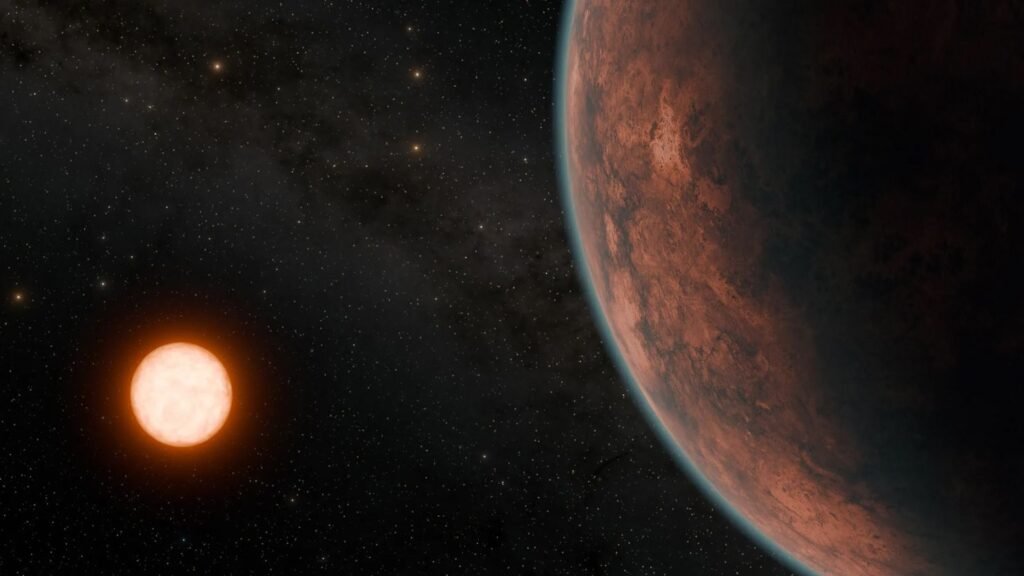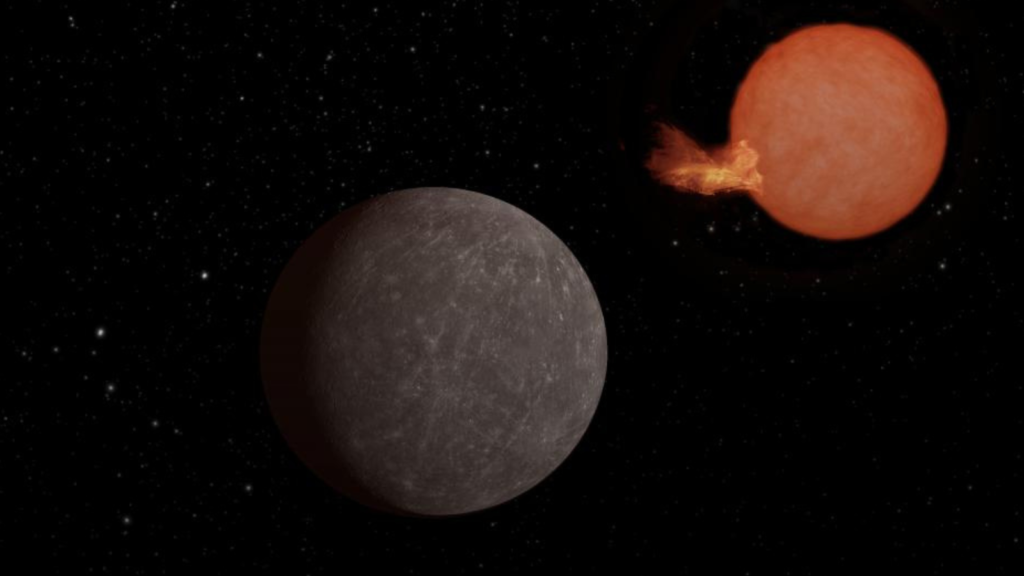In an exciting discovery that could change how we look at space and life beyond our solar system, astronomers have found a massive planet similar to Earth orbiting a red dwarf star only 154 light years away. This new world is about twice the size of Earth and is located in a zone where water could possibly exist in liquid form, raising hopes that it might support life.
The planet is named TOI 715 b. It was found using NASA’s Transiting Exoplanet Survey Satellite, or TESS. Later studies confirmed that the planet is rocky and sits in a special zone called the habitable zone. This means the temperature on the planet could be just right for water to remain in liquid form on its surface.
A Planet Twice the Size of Earth
TOI 715 b is what scientists call a Super Earth. This means it is larger than Earth but smaller than planets like Neptune or Uranus. It is about twice the diameter of Earth and likely has a rocky surface. A planet this size would have stronger gravity, but it could still be able to support some type of life if the right conditions exist.
The planet orbits its red dwarf star every 19 Earth days. That means a year on this planet is just 19 days long. Because red dwarf stars are cooler than our Sun, their habitable zones are closer in. This explains why TOI 715 b orbits so quickly.
What Makes This Planet Special
TOI 715 b stands out because it meets several key conditions that scientists look for when searching for other Earth like planets. It is a rocky planet, it is located in the habitable zone, and it is close enough to Earth for future telescopes to study it in detail.
It is not an exact copy of Earth, but it is one of the most promising planets yet discovered. Future space missions like the James Webb Space Telescope will be used to examine whether the planet has an atmosphere and what that atmosphere is made of. If it contains oxygen or methane, it could be a strong sign of life.
The Importance of Red Dwarf Stars
Red dwarf stars are the most common type of star in the Milky Way. They are smaller and cooler than our Sun and can live for trillions of years. Because they are so common, scientists believe they could host many planets in the habitable zone.
One challenge with red dwarfs is that they often give off strong bursts of radiation. This radiation could make it hard for life to survive unless the planet has a strong magnetic field or thick atmosphere to offer protection.
Still, planets around red dwarfs are of great interest because they are easier to find and study. The discovery of TOI 715 b adds more evidence that such stars may hold many Earth like planets.
How the Planet Was Discovered

NASA’s TESS mission found TOI 715 b by using the transit method. This method watches for small dips in a star’s brightness caused by a planet passing in front of it. Once this dip was seen, scientists used scientists other telescopes to confirm that a planet was really there.
After gathering more data, scientists were able to measure the planet’s size and orbit. They also learned how far it is from Earth and what kind of star it orbits. All this information helps them decide whether the planet is a good target for future research.
What This Discovery Means
Finding TOI 715 b is not just a scientific success. It also gives us hope that Earth may not be the only planet in the universe with the right conditions for life. Knowing there could be other planets like ours helps us better understand our place in the cosmos.
As Dr Emily Sandford, an astrophysicist at Columbia University, said, this discovery is a reminder that Earth may not be unique. With every new planet we find in the habitable zone, we get closer to answering the age old question of whether we are alone in the universe.
Could Life Exist There
Right now, we don’t know if TOI 715 b can support life. But if it has the right kind of atmosphere and the right surface conditions, life may be possible. Scientists will look for signs called biosignatures. These include gases like oxygen or methane that often come from living things.
Even if no life is found, the discovery is still very useful. It shows that we have the tools to find and study Earth like planets. And it brings us closer to finding one that may be a better match for life as we know it.
What Comes Next
Now that TOI 715 b has been discovered, the next step is to study it in more detail. Space telescopes like the James Webb Space Telescope will help researchers look for an atmosphere and study what it is made of.
Scientists also want to know if the planet has moons or other planets in the same system. They are especially interested in any other planets that might also be in the habitable zone.
Other space agencies are planning similar missions. The European Space Agency, for example, will launch the Ariel mission later this decade to study exoplanet atmospheres.
A Glimpse of the Future

TOI 715 b is not the final goal. It is a stepping stone. Each planet we discover brings us closer to understanding how common Earth like worlds really are. With each new mission, we improve our tools and expand our knowledge.
One day, these discoveries may lead to real answers about life beyond Earth. They may even guide future human missions to distant worlds.
For now, TOI 715 b stands as a powerful symbol of what science can achieve. It reminds scientist that the universe is full of possibilities, and the next Earth like planet might be even closer than we think.
The Scientific Importance of TOI 715 b
The discovery of TOI 715 b has added a valuable new target for exoplanet research. Scientists are especially excited about this planet because it fits into a category that astronomers rarely get to study in such detail — a rocky Super Earth in the habitable zone of a red dwarf. These planets are difficult to find and even harder to analyze, but they offer the best chance to search for signs of life outside our solar system.
What makes TOI 715 b scientifically important is that it checks multiple boxes for habitability. It is relatively nearby in galactic terms, it is large enough for telescopes to observe easily, and it may have the right temperatures for liquid water. All of these factors make it a strong candidate for further study.
Its size also allows researchers to study how Super Earths form and how their atmospheres behave. Since Earth is currently the only planet known to support life, scientists are eager to learn whether planets slightly larger than Earth might also be habitable or even more suitable for life in certain ways.
Future Missions Could Unlock More Secrets
The James Webb Space Telescope (JWST) is expected to play a major role in the next stage of research on TOI 715 b. It has the ability to study exoplanet atmospheres by analyzing the light that passes through them when the planet transits its star. This light can reveal the chemical makeup of the atmosphere, including any gases associated with life.
If TOI 715 b has an atmosphere, JWST could detect elements like carbon dioxide, water vapor, or even oxygen and methane. These gases can provide strong clues about surface conditions and whether biological processes might be taking place.
Other missions, such as the European Space Agency’s PLATO and Ariel telescopes, will scientists also contribute to understanding this planet and others like it. These missions are designed specifically to study exoplanets and could offer valuable data on climate, cloud formation, and temperature ranges.
What Would It Be Like to Live There

While TOI 715 b is located in the habitable zone, life there — if it exists — would likely be very different from Earth. The planet orbits much closer to its red dwarf star than Earth does to the Sun. This means the planet may be tidally locked, with one side always facing the star while the other remains in darkness.
In such a scenario, extreme temperature differences could exist between the day side and night side of the planet. However, if TOI 715 b has a thick atmosphere, it might help spread heat evenly across the surface, making the planet more comfortable for potential life.
Gravity on TOI 715 b would also be stronger due to its larger size. A human visiting the planet might feel twice as heavy. Walking, movement, and even how blood flows in the body could be different. These challenges would need to be addressed if humans ever explored or colonized such a planet.
A Growing Catalog of Earth-like Worlds
TOI 715 b is just one of thousands of exoplanets discovered in recent years, but it stands out because of how closely it resembles Earth in terms of habitability. It adds to a growing list of promising planets such as Kepler 452 b, Proxima b, and TRAPPIST 1 e, all of which orbit stars in or near the habitable zone.
Each of these discoveries gives scientists a better idea of scientists how common Earth-like planets really are. So far, it seems that our galaxy may be filled with them. Some estimates suggest that there could be billions of rocky planets in habitable zones around stars across the Milky Way.
This opens up a huge range of possibilities for future exploration. While traveling to these planets with current technology is not yet possible, robotic missions and advanced telescopes can bring us closer to understanding them.
A New Era in Astronomy
The discovery of TOI 715 b marks another step forward in the exciting journey to find other Earths. With more powerful tools being launched every year and growing international interest in space science, the next decade promises to be full of new breakthroughs.
TOI 715 b reminds us that our solar system is not alone in hosting potentially habitable worlds. It sparks our imagination, drives scientific innovation, and keeps alive one of humanity’s oldest dreams — finding life beyond Earth












Leave a comment